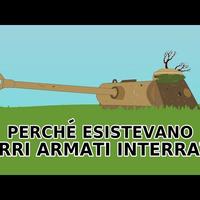A cosa servivano i CARRI ARMATI INTERRATI? | Le curiosità della STORIA
at|what|they were used for|the|vehicles|armed|buried|the|curiosities|of the|history
||serviam para||||enterrados||||
Wofür wurden unterirdische Tanks verwendet? | Kuriositäten der GESCHICHTE
¿Para qué se usaban los tanques subterráneos? | Curiosidades de la HISTORIA
A quoi servaient les réservoirs souterrains ? | Curiosités de l'histoire
地下タンクは何に使われていたのか?| 地下タンクは何に使われていたのか?
do czego służyły podziemne tarcze wojskowe? | ciekawostki z historii
Para que serviam os tanques subterrâneos? | Curiosidades da HISTÓRIA
Для чего использовались подземные резервуары? | Курьезы истории
VAD VAR ANVÄNDNINGEN AV UNDERGROUND ARMY TARS? | HISTORY Trivia
What were the purpose of the BURIED TANKS? | Curiosities of HISTORY
perché esistevano dei carri armati interrati? Seconda guerra mondiale
why|there existed|some|tanks|armed|buried|Second|war|world
Why did buried tanks exist? Second World War
L'idea di una fortificazione fatta con una torretta di un carro armato, risale alla prima
the idea|of|a|fortification|made|with|a|turret|of|a|vehicle|armed|dates back|to the|first
|||||||torre|||tanque||remonta||
The idea of a fortification made with a turret from a tank dates back to the first
guerra mondiale, grazie ai francesi e il loro innovativo veicolo corazzato leggero FT-17.
war|worldwide|thanks|to the|French|and|the|their|innovative|vehicle|armored|light|FT-17
||||||||||blindado|leve|
World War, thanks to the French and their innovative light armored vehicle FT-17.
Questo cingolato disponeva di una torretta che poteva girare completamente, dando un
this|tracked vehicle|it had|of|a|turret|which|it could|to turn|completely|giving|a
|vehículo de orugas||||||||||
|veículo rastreador||||||||||
This tracked vehicle had a turret that could rotate completely, providing a
grosso vantaggio sul campo di battaglia. Durante il periodo interbellico, l'FT-17 fornì
big|advantage|on the|field|of|battle|During|the|period|interwar|the FT-17|provided
a great advantage on the battlefield. During the interwar period, the FT-17 provided
l'ispirazione ad altri paesi, di realizzare rapidamente i propri carri armati moderni,
the inspiration|to|other|countries|to|to realize|quickly|the|own|tanks|armed|modern
inspiration to other countries to quickly develop their own modern tanks,
e il ritmo di sviluppo rese obsoleti altri modelli, che potevano essere rottamati per
and|the|pace|of|development|made|obsolete|other|models|which|they could|to be|discarded|for
||||||||||||desechados|
|||||tornou|obsoletos||||||descontinuados para|
and the pace of development rendered other models obsolete, which could be scrapped for
recuperare il metallo o messi nei musei. Tuttavia tre paesi: Belgio, Francia e Unione
to recover|the|metal|or|placed|in the|museums|However|three|countries|Belgium|France|and|Union
metal recovery or placed in museums. However, three countries: Belgium, France, and the Soviet Union,
Sovietica, decisero di utilizzare i loro vecchi carri armati in modo diverso, ovvero come
Soviet|they decided|to|to use|the|their|old|tanks|armed|to|way|different|that is|as
decided to use their old tanks differently, namely as
fortificazioni fisse. Il Belgio per proteggere le sue coste e i
fixed fortifications|fixed|The|Belgium|to|protect|the|its|coasts|and|
|fijas|||||||||
|fixas|||||||||
fixed fortifications. Belgium to protect its coasts and its
suoi confini; L'Unione Sovietica, che fu la prima ad avere
its|borders|The Union|Soviet|which|was|the|first|to have|
borders; The Soviet Union, which was the first to have
l'idea, per proteggere la Linea Stalin e Molotov. E la Francia per aumentare la difesa della
the idea|to|protect|the|Line|Stalin|and|Molotov||the|||||defense|of the
the idea, to protect the Stalin and Molotov Line. And France to enhance the defense of the
linea Maginot. Non è chiaro se questi paesi abbiano avuto
line|Maginot|Not|it is|clear|if|these|countries|they have had|
Maginot line. It is unclear whether these countries had
l'idea della torretta di un carro armato fortificata in modo indipendente o tramite spionaggio.
the idea|of the|turret|of|a|tank|armed|fortified|in|way|independently|or|through|espionage
the idea of a fortified tank turret independently or through espionage.
Nel 1935, le Tourelle démontable furono installate lungo la linea Maginot.
In|the|turrets|removable|they were|installed|along|the|line|Maginot
In 1935, the removable Tourelle were installed along the Maginot Line.
Questa torretta girevole poteva essere trasportata e interrata e per l'installazione sarebbero
this|turret|rotating|could|to be|transported|and|buried||for|the installation|they would be
||giratória|||transportada||||||
This rotating turret could be transported and buried, and it would take
state necessarie tre ore e mezza e poteva essere posizionata in modo permanente.
they were|necessary|three|hours|and|half||it could|to be|positioned|in|way|permanent
three and a half hours for installation and could be positioned permanently.
Sebbene fosse fissata in modo permanente, doveva essere nascosta per evitare sabotaggi
although|it was|fixed|in|way|permanent|it had to|to be|hidden|to|to avoid|sabotages
||||||||escondida|||sabotagens
Although it was fixed permanently, it had to be hidden to avoid sabotage
da parte del nemico. Contestualmente, le torrette dei carri armati
from|part|of the|enemy|At the same time|the|turrets|of the|tanks|armed
by the enemy. At the same time, the tank turrets
erano considerate delle fortificazioni economiche utili a integrare le difese della linea Maginot.
they were|considered|some|fortifications|economic|useful|to|to integrate|the|defenses|of the|line|Maginot
they were considered useful economic fortifications to supplement the defenses of the Maginot Line.
L'FT-17 era ormai obsoleto, e la maggior parte si trovava nei magazzini, essendo stato rimpiazzato
the FT-17|it was|by now|obsolete|and|the|most|part|it|found|in the|warehouses|having been|was|replaced
|||||||||||almacenes|||
|||||||||||armazéns|||substituído
The FT-17 was now obsolete, and most of them were in storage, having been replaced
da nuovi modelli come il Renault R 35 e il Somua S35,
from|new|models|like|the|Renault|R|and|the|Somua|S35
by new models like the Renault R 35 and the Somua S35,
E così diventò la scelta perfetta, oltre a essere rottamati, per formare una linea
and|so|it became|the|choice|perfect|besides|to|being|discarded|to|to form|a|line
And so it became the perfect choice, in addition to being scrapped, to form a line
di difesa di seconda linea. Privo di motore e cingoli, l'intero carro
of|defense|of|second|line|Devoid|of|engine|and|tracks|the entire|tank
|||||||||orugas||
|||||sem||||lagartas||
of secondary defense. Lacking an engine and tracks, the entire tank
armato veniva sepolto e cementificato nel terreno, lasciando esposta la sola torretta.
armed|he was|buried|and|cemented|in the|ground|leaving|exposed|the|only|turret
||enterrado||cementado||||exposta|||
the armed one was buried and cemented in the ground, leaving only the turret exposed.
Così come la mitragliatrice e i cannoni da 37 millimetri, il modello radiocomandato,
as well as|like|the|machine gun|and|the|canons|of|millimeters|the|model|remote-controlled
Just like the machine gun and the 37 millimeter cannons, the remote-controlled model,
noto come FTT SF, venne impiegato come postazione di osservazione.
known|as|FTT|SF|it was|employed|as|station|of|observation
known as FTT SF, was used as an observation post.
Alcune di queste torrette sulla linea Maginot sono visibili ancora oggi.
some|of|these|turrets|on the|line|Maginot|they are|visible|still|today
Some of these turrets on the Maginot Line are still visible today.
Quando le forze tedesche conquistarono Belgio w Francia, e in seguito invasero l'Unione
when|the|forces|German|they conquered|Belgium|and|France|and|into|subsequently|they invaded|the Union
When the German forces conquered Belgium and France, and later invaded the Union
Sovietica nel 1941, fecero degli studi su queste fortificazioni.
Soviet|in|they did|some|studies|on|these|fortifications
Soviet in 1941, they conducted studies on these fortifications.
Nel 1942, i carri armati francesi e cechi conquistati due anni prima, e i primi panzer,
In|the|tanks|armed|French|and|Czech|conquered|two|years|before||the|first|panzers
||||||||||||||tanques
In 1942, the French and Czech tanks captured two years earlier, and the first panzer,
ormai obsoleti, furono impiegati come torrette dall'esercito tedesco e montati sui loro bunker,
by now|obsolete|they were|employed|as|turrets||German|and|mounted|on the|their|bunkers
now obsolete, were used as turrets by the German army and mounted on their bunkers,
per difendere il Vallo Atlantico. Nel 1943, le forze tedesche presero una decisione
to|defend|the|Wall|Atlantic|In|the|forces|German|they took|a|decision
|||||||||tomaram||
to defend the Atlantic Wall. In 1943, the German forces made a radical decision
radicale. Le torrette dei corazzati Panther furono scelte
radical|the|turrets|of the|armored|Panther|they were|chosen
The turrets of the Panther armored vehicles were chosen.
per diventare torrette fortificate, nonostante fino a quel momento solo i carri armati obsoleti
to|become|turrets|fortified|despite|until|at|that|moment|only|the|vehicles|armed|obsolete
to become fortified turrets, despite the fact that until that moment only obsolete tanks
venivano convertiti con questo scopo. Da questo momento, iniziarono a impiegare
they were coming|converted|with|this|purpose|From|this|moment|they started|to|to employ
were being converted for this purpose. From this moment on, they began to employ
carri armati recenti. Il Panther fu scelto per la sovrapproduzione
tanks|armed|recent|The|Panther|it was|chosen|for|the|overproduction
|||||||||superprodução
recent tanks. The Panther was chosen for the overproduction
di torrette, e poiché poteva assumere l'aspetto dei più recenti corazzati alleati.
of|turrets|and|since|it could|to assume|the appearance|of the|more|recent|armored|allied
of turrets, and because it could take on the appearance of the latest allied armored vehicles.
Sarebbe stato noto come Panther Ausf Turm. Per adattarla a questo scopo, fu leggermente
it would be|has been|known|as|Panther|version|tower|to|to adapt it|to|this|purpose|it was|slightly
It would be known as Panther Ausf Turm. To adapt it for this purpose, it was slightly
modificato. La cupola del comandante fu sostituita da
modified|the|dome|of the|commander|was|replaced|by
modified. The commander's cupola was replaced by
un portello, e il suo tetto venne rinforzato, con un'armatura da 40 millimetri, anziché
a|door|and|the|its|roof|was|reinforced|with||of|millimeters|instead of
|portão|||||||||||
a hatch, and its roof was reinforced with 40 millimeter armor, instead of
16, di spessore, per compensare la sua posizione statica e resistere agli attacchi aerei o
of|thickness|to|to compensate|the|its|position|static|and|to resist|to the|attacks|air|or
16, in thickness, to compensate for its static position and withstand air or
di artiglieria. Due versioni di Panther Ausf. Turm vennero
of|artillery|Two|versions|of|Panther|Ausf|turret|were
artillery attacks. Two versions of Panther Ausf. Turm were
adottate. Una posizionata in un bunker d'acciaio e un'altra
adopted|One|positioned|in|a|bunker|of steel|and|another
adopted. One positioned in a steel bunker and another
con fondamenta in cemento. Era prevista anche una versione in un bunker
with|foundations|in|cement|It was|planned|also|a|version|in|a|bunker
with concrete foundations. A version in a bunker was also planned.
di legno, ma mai utilizzata. Nella parte superiore, la zona da combattimento,
of|wood|but|never|used|In the|part|upper||area|to|fighting
of wood, but it was never used. In the upper part, the combat area,
mentre nel piano sottostante, gli alloggi, con riscaldamento e generatore elettrico.
while|in the|plan|underlying|the|accommodations|with|heating|and|generator|electric
|||||habitações|||||
while on the lower floor, the accommodations, with heating and electric generator.
Queste torrette potevano sfondare l'armatura dei carri armati alleati, ma potevano anche
these|turrets|they could|break through|the armor|of the|tanks|armed|allied|but|they could|also
These towers could break through the armor of allied tanks, but they could also
essere accerchiate dalle truppe alleate, per via della loro posizione fissa, e colpite
to be|surrounded|by the|troops|allied|by|way|of the|their|position|fixed|and|hit
|cercadas|||||||||||atacadas
be surrounded by allied troops, due to their fixed position, and hit.
ai lati dove l'armatura era più debole. Questi bunker Panther vennero usati principalmente
at the|sides|where|the armor|was|more|weak|These|bunkers|Panther|were||mainly
at the sides where the armor was weaker. These Panther bunkers were mainly used
sul fronte occidentale come parte del Vallo Atlantico, come linea difensiva occidentale
on the|front|western|as|part|of the|Wall|Atlantic||line|defensive|western
on the western front as part of the Atlantic Wall, as the western defensive line
della Germania e per le linee difensive in Italia.
of the|Germany|and|for|the|lines|defensive|in|Italy
of Germany and for the defensive lines in Italy.
Pochissimi di loro furono utilizzati sul fronte orientale.
very few|of|them|they were|used|on the|front|eastern
Very few of them were used on the eastern front.
I Pantherturm furono sfruttati fino alla fine, come misura disperata durante la Battaglia
the|Panther towers|they were|exploited|until|the|end|as|measure|desperate|during|the|Battle
|||explorados|||||||||
The Pantherturm were exploited until the end, as a desperate measure during the Battle
di Berlino.
of|Berlin
of Berlin.
SENT_CWT:ANo5RJzT=4.79 PAR_TRANS:gpt-4o-mini=2.31
en:ANo5RJzT
openai.2025-01-22
ai_request(all=68 err=0.00%) translation(all=56 err=0.00%) cwt(all=654 err=2.45%)

